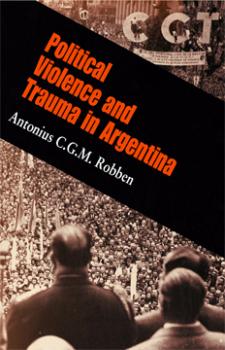ТОП просматриваемых книг сайта:
Историческая литература
Различные книги в жанре Историческая литература, доступные для чтения и скачиванияPolitical Violence and Trauma in Argentina - Antonius C. G. M. Robben
The Ethnography of Political ViolenceАннотация
For decades, Argentina's population was subject to human rights violations ranging from the merely disruptive to the abominable. Violence pervaded Argentine social and cultural life in the repression of protest crowds, a ruthless counterinsurgency campaign, massive numbers of abductions, instances of torture, and innumerable assassinations. Despite continued repression, thousands of parents searched for their disappeared children, staging street protests that eventually marshaled international support. Challenging the notion that violence simply breeds more violence, Antonius C. G. M. Robben's provocative study argues that in Argentina violence led to trauma, and that trauma bred more violence. In this work of superior scholarship, Robben analyzes the historical dynamic through which Argentina became entangled in a web of violence spun out of repeated traumatization of political adversaries. This violence-trauma-violence cycle culminated in a cultural war that «disappeared» more than ten thousand people and caused millions to live in fear. Political Violence and Trauma in Argentina demonstrates through a groundbreaking multilevel analysis the process by which different historical strands of violence coalesced during the 1970s into an all-out military assault on Argentine society and culture. Combining history and anthropology, this compelling book rests on thorough archival research; participant observation of mass demonstrations, exhumations, and reburials; gripping interviews with military officers, guerrilla commanders, human rights leaders, and former disappeared captives. Robben's penetrating analysis of the trauma of Argentine society is of great importance for our understanding of other societies undergoing similar crimes against humanity.
Информация о книге
Автор произведения Antonius C. G. M. Robben
Аннотация
Аннотация
The Master of Game is the oldest and most important work on the chase in the English language. Based primarily on Gaston de Foix's Livre de chasse , originally composed in 1387, The Master of Game was written by Edward of Norwich at his leisure between 1406 and 1413, mostly while being held prisoner for having treasonous designs against his cousin, Henry IV. While much of the book is almost an exact translation of de Foix, Edward added five chapters of his own to form the major source for our knowledge of the medieval hunt. The book begins with a description of the nature of popular quarry, such as the hare, deer, and badger, including their behavior, characteristics, and even smells, and then moves to a discussion of various hunting dog breeds and how to train them. The medieval chase was a ritual event, so the book continues with an explanation of the various rules and techniques for a successful hunt, including how food was to be distributed among the hunters, the support persons, and the dogs. Weapons and traps of choice are also described, as well as the different horn calls used for communication. The Master of Game is a unique text for naturalists, hunters, and persons interested in social history. Although hunting is nowadays far removed from most people's experience, it was of major interest in the time of Edward of Norwich for ritual, sport, and, of course, food. Some knowledge of the chase was essential for all persons of medieval times. This edition, the first paperback ever of the original version edited in 1909, includes a hearty foreword by Theodore Roosevelt, who adds some important contextual information about the chase and draws on his own vast hunting experience. A delight to read, even for those who are not keen on the sport, The Master of Game has, as one review exclaimed," all Chaucer's freshness, love of the open sky and fragrant woodland."
“Nailed to the rolls of honour, crucified”: Irish Literary Responses to the Great War - Robert Starr
Аннотация
This book explores the war writings of Patrick MacGill, James Hanley, and Liam O’Flaherty, working class, Roman Catholic Irishmen, all of whom fought in the First World War as privates and who, collectively, it is argued, constitute a distinct trio of war writers. Through discussions focusing upon class, camaraderie, violence, religion, trauma, and the body, this book considers these Irish soldiers within a cultural, social, and historical context. Central to this examination is the idea that the motives for enlistment and the experience of army labor and even combat was such that military service was perceived as work rather than a duty or vocation undertaken in support of any prevailing doctrines of patriotism or sacrifice. The men’s Catholicism also shaped their aesthetic and philosophical responses to the war, even while the war conversely troubled their faith or confirmed their religious scepticism. The war writing of these men is located within both an Irish and a pan-European literary working class tradition, thereby permitting the texts to be viewed within a wider context than literature of the First World War, and from a perspective that goes beyond Ireland and Britain. These characteristics shape a perspective on the conflict very different from that of the canonical officer-writers, men such as Siegfried Sassoon, Robert Graves, or Edmund Blunden, whose work is considered alongside those of the three Irish soldier-writers.
Аннотация
"The Life and Afterlife of a Ukrainian Nationalist" is the first comprehensive and scholarly biography of the Ukrainian far-right leader Stepan Bandera and the first in-depth study of his political cult. In this fascinating book, Grzegorz Rossolinski-Liebe illuminates the life of a mythologized personality and scrutinizes the history of the most violent twentieth-century Ukrainian nationalist movement: the Organization of Ukrainian Nationalists and its Ukrainian Insurgent Army.
Elucidating the circumstances in which Bandera and his movement emerged and functioned, Rossolinski-Liebe explains how fascism and racism impacted on Ukrainian revolutionary and genocidal nationalism. The book shows why Bandera and his followers failed—despite their ideological similarity to the Croatian Ustaša and the Slovak Hlinka Party—to establish a collaborationist state under the auspices of Nazi Germany and examines the involvement of the Ukrainian nationalists in the Holocaust and other atrocities during and after the Second World War. The author brings to light some of the darkest elements of modern Ukrainian history and demonstrates its complexity, paying special attention to the Soviet terror in Ukraine and the entanglement between Ukrainian, Jewish, Polish, Russian, German, and Soviet history. The monograph also charts the creation and growth of the Bandera cult before the Second World War, its vivid revivals during the Cold War among the Ukrainian diaspora, and in Bandera's native eastern Galicia after the dissolution of the Soviet Union.
Elucidating the circumstances in which Bandera and his movement emerged and functioned, Rossolinski-Liebe explains how fascism and racism impacted on Ukrainian revolutionary and genocidal nationalism. The book shows why Bandera and his followers failed—despite their ideological similarity to the Croatian Ustaša and the Slovak Hlinka Party—to establish a collaborationist state under the auspices of Nazi Germany and examines the involvement of the Ukrainian nationalists in the Holocaust and other atrocities during and after the Second World War. The author brings to light some of the darkest elements of modern Ukrainian history and demonstrates its complexity, paying special attention to the Soviet terror in Ukraine and the entanglement between Ukrainian, Jewish, Polish, Russian, German, and Soviet history. The monograph also charts the creation and growth of the Bandera cult before the Second World War, its vivid revivals during the Cold War among the Ukrainian diaspora, and in Bandera's native eastern Galicia after the dissolution of the Soviet Union.
Аннотация
The history of Soviet nonconformism and, more broadly, of East European dissent has been written as a history of ideas, the subject of which is the transfer, internalization, and the subversive force of liberal values in socialist societies. In this sense, the nonconformist subconscious of totalitarian systems was expressed in the universal discourse of human rights. When the Helsinki Accords (CSCE) were signed by the Soviet Union in 1975, the commitment made there to respect for human rights and fundamental freedoms became en-forceable. Since then, freedom of expression, religion, belief, and conscience became rights that were part of the basic vocabulary of the civil rights movements formed illegally within nonconformist groups and networks within the Eastern Bloc. However, the right to private property, which means something essential in the liberal system of values, seems to have played no role in the development of this nonconformist discourse, or its role was at least not considered until now by historians of ideas and of culture. In the present contribution, I would like to begin by addressing the failure to reflect on the relationship between private property and the consensus on liberal values. I will do so in order to show how the discourse of property rights penetrated the Soviet culture of nonconformism and within a short time brought about signifi-cant changes in the social and economic practices of Soviet institu-tions, thus accelerating their decline … . (Aus dem Beitrag von Konstantin Kaminskij)










